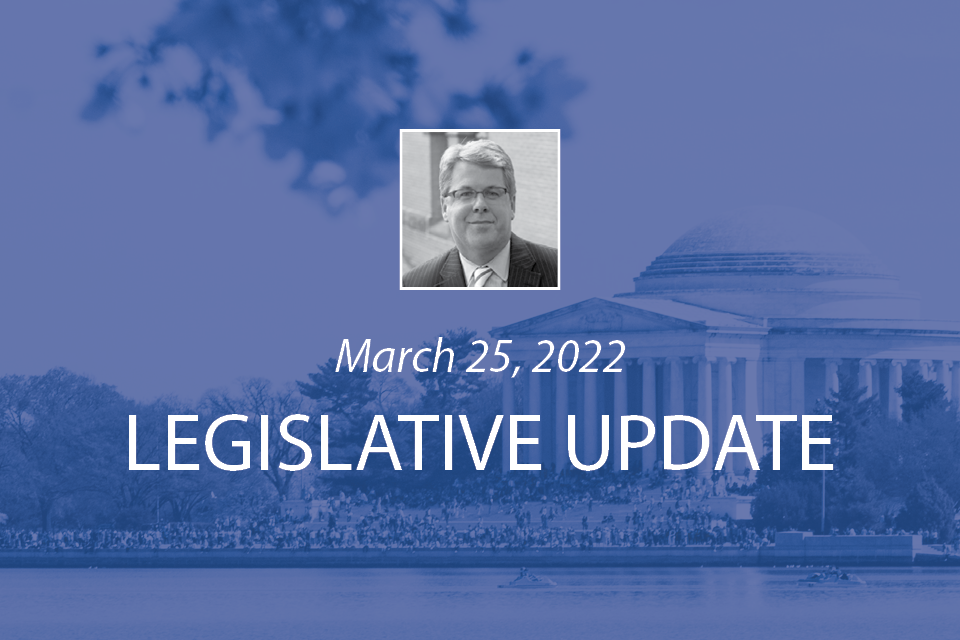Build Back Better
The ink on the obituary for the House-passed, $1.7 trillion Build Back Better legislation is about dry. There is little, if any, discussion on Capitol Hill about that proposal currently and we do not expect that to change. However, discussions are picking up on a modified proposal that would embody some of the climate change aspects of that legislation with some key differences. Senator Joe Manchin (D-WV) is once again at the center of negotiations, but it is unclear what portions of the climate package from the original BBB he still supports. What Sen. Manchin would like to add is an “all of the above” energy title to the bill that would attempt to address rising fossil fuel prices in the U.S. brought on in part by the crisis in Ukraine. This approach would be a significant departure from where the Administration and the Democrat caucus have been on climate policy and it is unclear whether the needle could be threaded to include some fossil fuel supply provisions with traditional renewable energy-focused language that was in the BBB. The process of pulling a package together is in its nascent stages. We are told that work on defining this proposal will occur during the April and May work periods when Senators are here in Washington. ABMA is close to the process and is keeping our eyes and ears open for “pay fors” to fund such a package, particularly those that would impact Main Street businesses.
Endangered Species Act Listing
On Wednesday, the U.S. Fish and Wildlife Service published a notice in the Federal Register proposing to list the Northern Longeared Bat (NLEB) as “endangered” under the Endangered Species Act. This bat has suffered high morbidity over the last several years due to a fungus known as White Nose Syndrome, which has devastated bat colonies. Typically, when a species receives the “endangered” tag there are a number of measures that are enforced to ensure that its habitat is preserved.
This is the second time the Service has acted on the NLEB. Back in 2014, USFWS proposed listing the NLEB as “endangered” and unveiled a habitat conservation plan (HCP) that essentially would have curtailed timber harvesting on public and private lands in the bat’s 38 state range. The forest products sector—from forest landowners to loggers to wood products mills–waged an advocacy campaign to educate lawmakers and the FWS that the bat was perishing due to White Nose Syndrome and declines in numbers had nothing to do with forest management. In fact, studies and data showed that the bat actually prefers and thrives in forests that have been managed compared to those that are not.
Ultimately, USFWS acknowledged this point and revised its proposal to list the NLEB as “threatened”—a less stringent tag—and finalized a reasonable habitat conservation plan that was workable for the sector. Now the Service is proposing to revisit the NLEB status and has proposed an “endangered” listing. The comment period for this proposal expires on May 23. We understand that states and regions have been developing their own workable HCPs in anticipation of this action. However, ABMA will be monitoring the issue closely and will report on developments.
Infrastructure Funding
On Wednesday, the Department of Transportation (DOT) rolled out a sizable funding notification for programs and projects that got a boost under the infrastructure law (Infrastructure Investment and Jobs Act –IIJA) enacted last year.
One of these–the Infrastructure for Rebuilding America (INFRA) program– is an existing competitive grant program that saw more than a 50 percent increase over 2021 due to the IIJA. Grants under this program fund highway, multimodal freight, and rail projects. Also, projects that reduce congestion and have the greatest potential to eliminate supply chain bottlenecks and improve truck and rail freight movements would be underwritten.
Last year, DOT received over $10 billion of project applications, but could only fund around $1 billion of these projects.
The IIJA provides approximately $8 billion for INFRA over 5 years, of which approximately $1.55 billion will be made available through this notice of funding opportunity (NOFO).
Another program is the Rural Surface Transportation Grant Program (RURAL) which was created by the IIJA. This program will fund projects to improve and expand the surface transportation infrastructure in rural areas to increase connectivity and improve safety and reliability of the movement of people and freight.
Eligible projects for rural grants will be those pertaining to highways, bridges, and tunnel projects that help improve freight and provide or increase access to agricultural, commercial, energy, or transportation facilities that support the rural economy. This year alone, DOT will award up to $300 million in grants through the rural program—part of the $2 billion included in the IIJA over five years.
The third tranche of funding that was announced is the National Infrastructure Project Assistance (MEGA) program that was also authorized in the IIJA to fund major projects that are too large or complex for traditional funding programs.
This program will provide grants on a competitive basis to support multijurisdictional or regional projects of significance that may also cut across multiple modes of transportation. Eligible projects could include highway, bridge, freight, port, passenger rail, and public transportation projects of national and regional significance.
Examples could be bridges or tunnels connecting two states; new rail and transit lines that improve equity and reduce emissions; and freight hubs integrating ship, train, and truck traffic.
DOT will award 50 percent of funding to projects greater than $500 million in cost and 50 percent to projects greater than $100 million but less than $500 million in cost.
The program will receive up to $1 billion this year alone and be able to provide multi-year funding to projects.
President’s Budget
The Biden Administration is expected to submit its proposed Fiscal Year 2023 budget to Congress on or about March 28. These documents, usually totaling thousands of pages, are typically aspirational and serve as more of a messaging document from the Administration about its policy and spending priorities. Submission of the President’s budget marks the unofficial start to the next fiscal year’s appropriations process. ABMA will be analyzing this document when it is unveiled to highlight areas that address our policy priorities like workforce development and supply chain.
House GOP Retreat
House Republicans decamped to Florida this week for their annual policy retreat. The main deliverable expected out of this meeting is for the various Republican policy task forces to report their findings which will help form the basis of a Commitment to America policy platform—a set of policy proposals that Republicans can campaign on later this Fall. House Republicans announced formation of these task forces last year. They are: Jobs and the Economy; Big Tech Censorship and Data; Future of American Freedoms; Energy, Climate, and Conservation; American Security; Healthy Future; and Competition with China.




